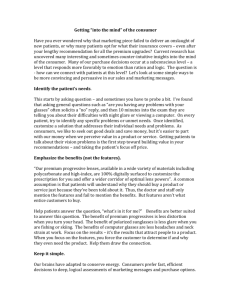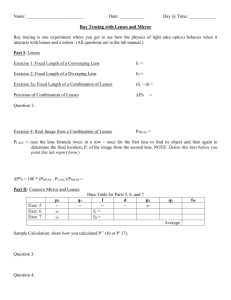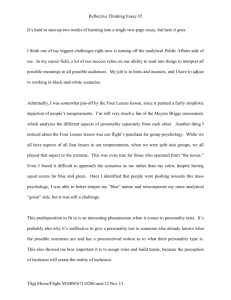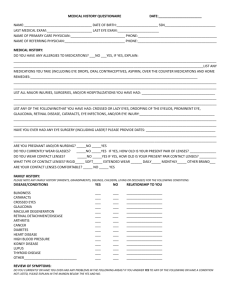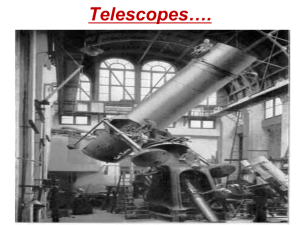Activity: Lenses and the Telescope
advertisement
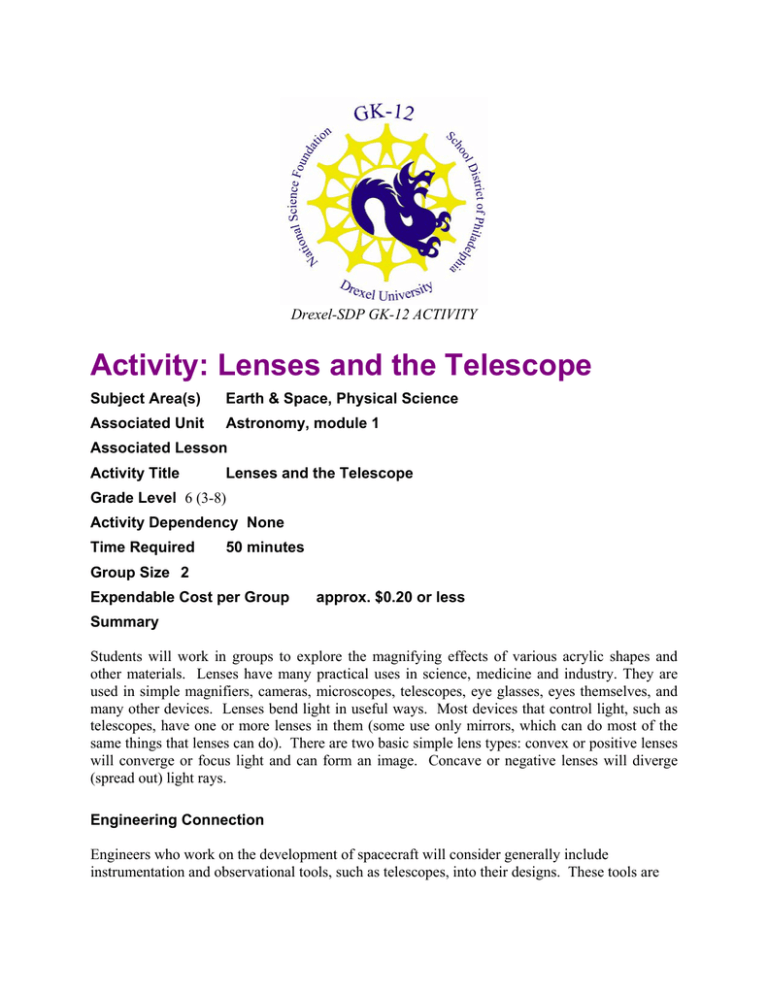
Drexel-SDP GK-12 ACTIVITY Activity: Lenses and the Telescope Subject Area(s) Earth & Space, Physical Science Associated Unit Astronomy, module 1 Associated Lesson Activity Title Lenses and the Telescope Grade Level 6 (3-8) Activity Dependency None Time Required 50 minutes Group Size 2 Expendable Cost per Group approx. $0.20 or less Summary Students will work in groups to explore the magnifying effects of various acrylic shapes and other materials. Lenses have many practical uses in science, medicine and industry. They are used in simple magnifiers, cameras, microscopes, telescopes, eye glasses, eyes themselves, and many other devices. Lenses bend light in useful ways. Most devices that control light, such as telescopes, have one or more lenses in them (some use only mirrors, which can do most of the same things that lenses can do). There are two basic simple lens types: convex or positive lenses will converge or focus light and can form an image. Concave or negative lenses will diverge (spread out) light rays. Engineering Connection Engineers who work on the development of spacecraft will consider generally include instrumentation and observational tools, such as telescopes, into their designs. These tools are necessary for the astronauts to perform their duties. Telescopes are also outfitted into satellites to take photographs and videos of planetary activities and other phenomena in space. Keywords Astronomy, lens, telescope, optics Educational Standards Pennsylvania Standards 3.7 Technological Devices 3.7.B. Use appropriate instruments and apparatus to study materials. Pre-Requisite Knowledge None. Learning Objectives • Students experiment with different acrylic shapes to learn which ones magnify. • Students discover the properties common to all objects that act as magnifiers. Materials List • • • • • • Square, sphere, and cylinder shaped transparent acrylic Wax Paper Water Water-dropper bottle 4 pieces of waxed paper (3-inches square) 4 pieces of newspaper (3-inches square) Introduction / Motivation Engineers play a large role in the exploration of our solar system and beyond. A tool that has enabled scientists to look at objects millions of miles away is the telescope. Similarly, there are objects that are so small that we need the help of magnification so that we can see them. In both a telescope and a microscope, there is a special tool that allows us to do these things? Who knows what it is called? (Lens). Students will work in groups to explore the magnifying effects of various acrylic shapes and other materials. Review the background material with the students, discuss the vocabulary, then begin the activity. Vocabulary / Definitions 2 Word Definition An optical grade glass which has two polished surfaces and is used to converge or diverge light rays. A surface curved like the interior of a circle or sphere. A surface curved like the exterior of a circle or sphere. Lens Concave Convex Procedure Background Lenses have many practical uses in science, medicine and industry. They are used in simple magnifiers, cameras, microscopes, telescopes, eye glasses, eyes themselves, and many other devices. Lenses bend light in useful ways. Most devices that control light, such as telescopes, have one or more lenses in them (some use only mirrors, which can do most of the same things that lenses can do). There are two basic simple lens types: convex or positive lenses will converge or focus light and can form an image. Concave or negative lenses will diverge (spread out) light rays. Before the Activity Collect and distribute materials. With the Students Procedure: 1. Designate one person from each team to pick up all supplies for the group. 2. Explain that that the teams of four will share equipment but that students will work individually 3. Distribute the Activity Sheet and preview it with the class. 4. Select and underline a word from the newspaper clipping. 5. Complete the Activity Sheet. Once students have finished testing all the solid objects to see if they magnify, they will test with a water drip. Students can follow the directions on the Direction Sheet. An outline of the directions is given below. Use this to preview the activity with your students. • • • Lay a piece of waxed paper on tip of the underlined word and see it the word is magnified. Take the waxed paper off of the word and put one drop of water on the waxed paper. Examine the water drop from the top and side. Based on what you have learned about which shapers magnify, predict whether the drop will magnify and record your prediction. Slide the waxed paper and water drop onto the word. Does the water drop magnify? Record in words and sketches the results of the test. 6. Allow students sufficient time to complete the activities. Circulate the classroom 7. After students have completed their observations discuss the common properties of magnifiers. Which shapes magnified, which did not. 3 8. Distribute the hand lenses. Ask students how the hand lens is like the other objects that acted as magnifiers, (All are clear with curved surfaces.) 9. Have students return all materials to their designated place. Safety Issues • None Troubleshooting Tips Help the students to deposit only a small drop of water onto the acrylic. Investigating Questions NAME: _________________________________ DATE: __________________________________ Sketch and label the object Predict: Will this object magnify? Test: Does this object magnify? Sketch the underlined word as it looked through the object 4 Assessment Pre-Activity Assessment None Activity Embedded Assessment Have the student groups complete the worksheet as they proceed through the activity. Post-Activity Assessment Evaluation will be based upon teacher observation of student participation, and completion the worksheet. Activity Extensions If magnifying lenses are available, ask the students to compare the magnifying power of the water droplet versus the lens. Owner Drexel University GK-12 Program Contributors Theresa Andrejack Copyright Copyright 2007 Drexel University GK12 Program. Reproduction permission is granted for nonprofit educational use Version: Mar 2007 5

